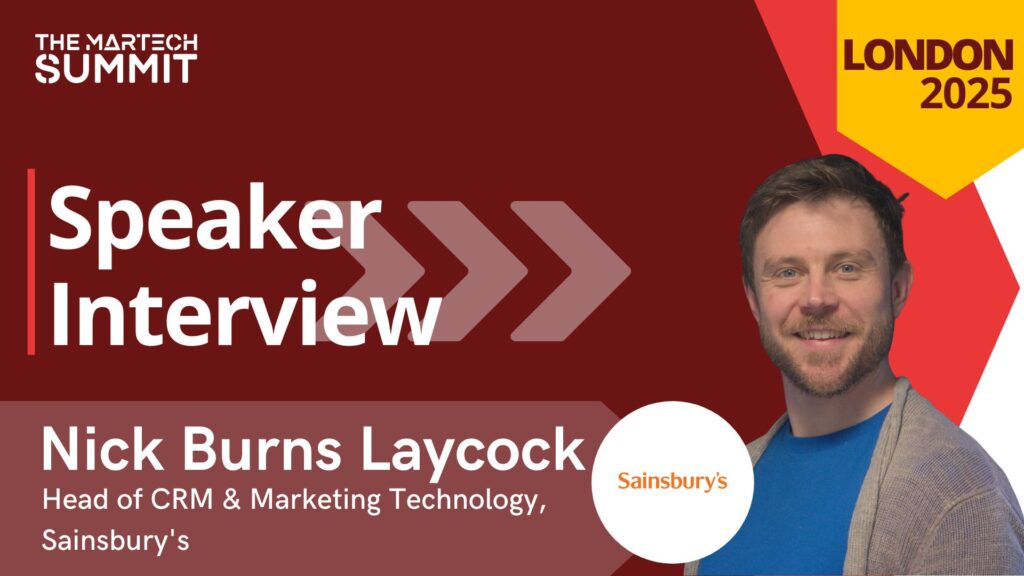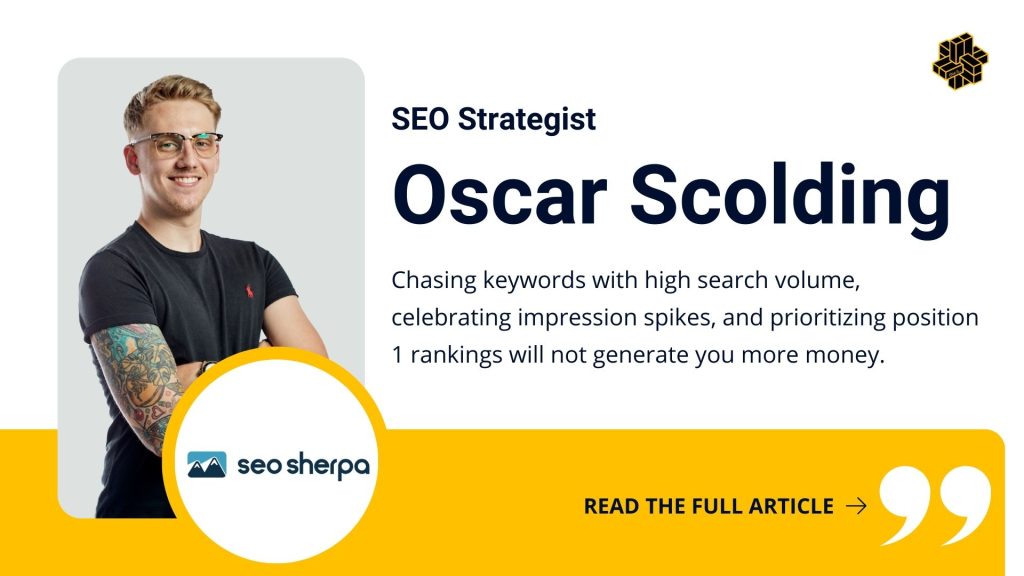
Ignore the SEO vanity metrics: Why ROI should be the #1 focus
The SEO industry has an OBSESSION with vanity metrics… and it’s one of the biggest reasons why many businesses end up losing out on millions in revenue.
But what if you could change this? Instead of chasing rankings, I can help to show you how you can build an SEO strategy that directly targets revenue.
I often hear teams placing too much emphasis on the wrong metrics and KPIs (key performance indicators). The most common ones?
- Domain authority
- Number of links
- Impressions
- Sessions
- Keyword rankings
- + more
Now, I’m not saying these things aren’t important. They absolutely are.
However, many campaigns are optimised towards these metrics, and not the one that matters the most – revenue and ROI.
These metrics are the building blocks of your campaign and should not be treated as the end goal.
I’ve consulted with hundreds of businesses that place these vanity metrics as their number one priority without thinking about how much revenue SEO can generate for them.
Crazy right?
I want to share with you why ROI needs to be the ultimate goal, and how your SEO should be structured with this in mind.
Now this content is aimed at businesses that are early in their SEO journey. For many brands, the priority may be different – with a greater focus on things such as thought-leadership-led content that targets a higher stage of the funnel.
But for the brands that are looking to make some serious revenue through their website, this will serve as a roadmap for future success.
But first…
What qualifies me to say these things?
I’ve been in the digital marketing industry for over 10+ years – leading SEO and performance marketing strategies for some of the biggest brands in the world, such as Amazon, GEMS Education, Pretty Little Thing & more.

In my current role as a Senior Strategist at SEO Sherpa (5x winner of the MENA Search Awards Best Large SEO Agency, and recent winner of the Global Search Awards Best Large SEO Agency), I’ve consulted with hundreds of businesses across 60+ industries and five continents, and there’s very few situations that I haven’t encountered.
Auditing this much business data over the years has given me a unique perspective on where brands should truly be focusing their SEO efforts to get the most ‘bang for their buck’.
So, why are vanity metrics such a problem?
Chasing keywords with high search volume, celebrating impression spikes, and prioritising position 1 ranking keywords will not generate you more money.
Let me show you an example…
Many brands spend their time chasing keywords with the most searches, thinking this will bring them great results.
But what’s the commercial intent of these keywords?
Broad, generic keywords don’t typically speak to a specific audience, and as such have a lower level of commercial intent, i.e. how likely the person searching that keyword is to convert.
The more searches a keyword has, typically, the harder it is to compete for it, too.
For example, the keyword “bike” has 165,000 searches per month in the United States, and the keyword difficulty score is 76% (very hard). Data extracted from SEMrush.
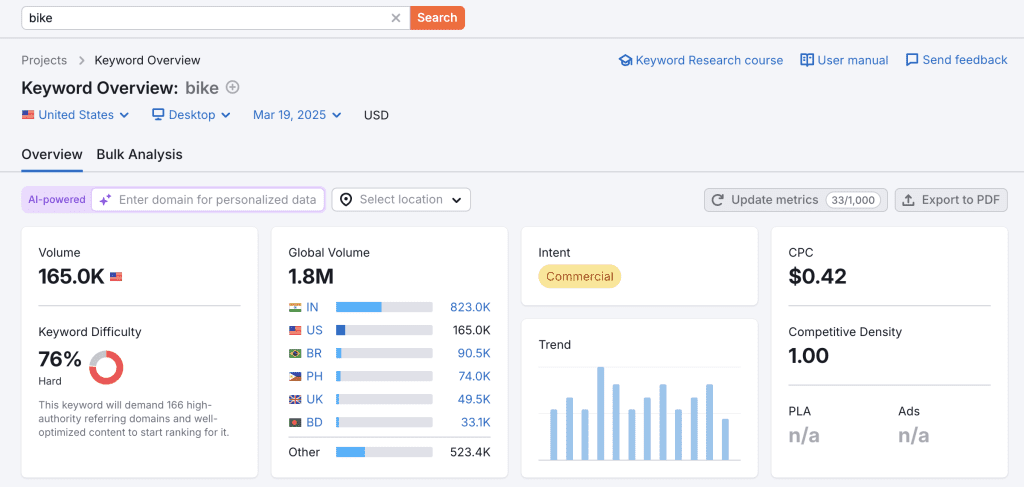
Why are people searching for “bike”? To purchase, rent, repair, or learn how to ride one?
Even if you were to be on the first page of Google for this term, there’s a good chance what they’re looking for and what you offer are two separate things.
And what is the likelihood of you beating the massive brands already featured on this page? Next to none.
However, we can take a look at a different example and find terms that have a greater chance of making you money.
The keyword “buy a road bike online” has less than 1,000 searches per month, but is also considerably less competitive.
This has a much higher level of commercial intent though, right?
So it’s important to not just focus on the big searches – find the low hanging fruit at a more competitive level.
How to calculate the ROI for SEO
To start, we need to be able to calculate the ROI return for SEO. Without this, we’re flying blind.
The formula is straightforward:
(Revenue from organic traffic – SEO costs) ÷ SEO costs x 100 = ROI (%)
Start by tracking conversions from organic traffic using GA4 (Google Analytics).
Multiply by your average order value or customer lifetime value to estimate revenue.
Next, total your SEO costs… agency fees, tools, content creation, and in-house salaries, etc. For example, if you spend $5,000 on SEO and generate $20,000 in organic revenue, your ROI is 300%.
However, calculating ROI can vary between e-commerce and lead generation businesses.
For e-commerce, it’s fairly simple – looking at basket values using the same data as above.
For lead generation, we need to work out the value of a lead – this is done by understanding the lead to close rate, and the average customer value.
For instance if a new customer is worth $10,000, and you have a lead to sale rate of 5% – each lead you generate is worth $500. This can then be used to calculate the ROI for SEO in lead generation businesses.
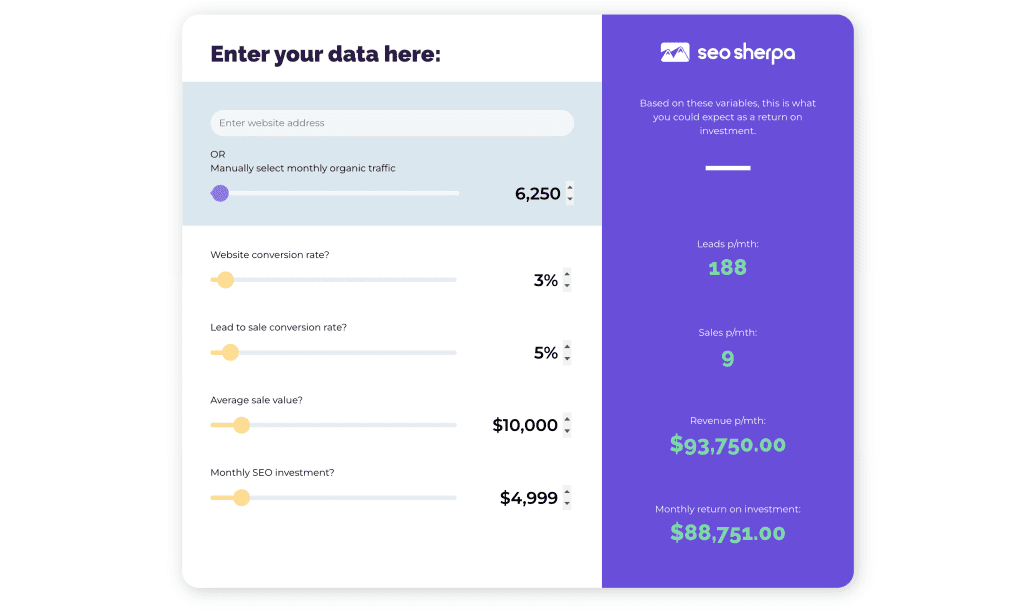
With these numbers in mind, we can start to assign a monetary value to traffic being driven to the website, which leads us to create the strategy itself.
How you can create ROI-led SEO campaigns (5 actionable examples)
Shifting your SEO strategy first needs to start with shifting your mindset.
Rather than starting with the ‘important SEO metrics’ – start with your customers and learn how they think, feel and act when purchasing a product.
The following examples are things that I have implemented for countless brands to help them generate more revenue through their website – and you will be able to do the same.
1. Focus on the high conversion rate keywords
This isn’t data you can get from SEMrush, ahrefs or any of the popular tools. However, you can find this data yourself by using Google Ads.
Google ads and SEO should be working hand-in-hand. The ads that you run will give you an extra layer of data that you cannot get anywhere else.
By filtering the search terms in Google Ads, you can start to compare the terms vs. number of conversions and conversion rates, as shown below.
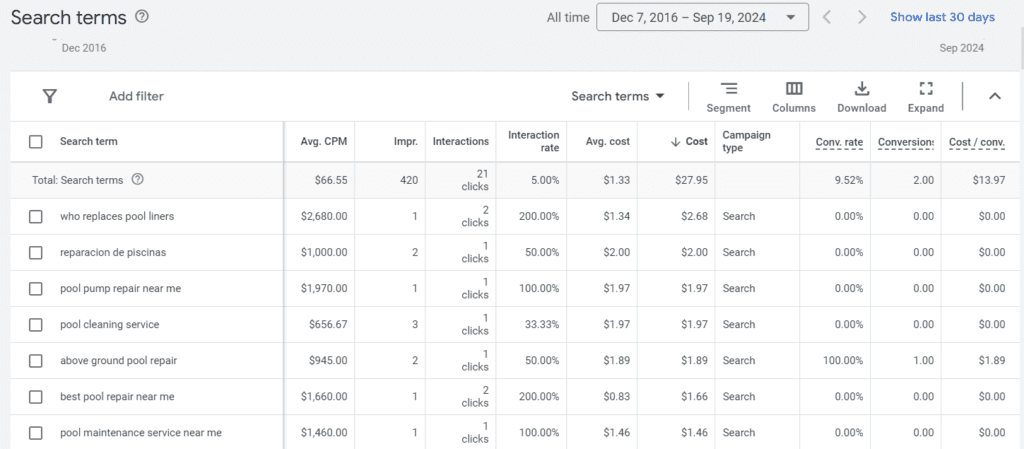
Using this data, you can start to pull out the best converting paid keywords and apply this to your SEO strategy.
Go into Google and manually search for these keywords – understand who is performing well and where you are currently positioned – and optimise the most relevant page for the query.
What happens if you don’t have a page that is relevant for that specific keyword? Create one!
This is a great way to find gaps in your SEO so you can start to build a content strategy around this.
2. Prioritise revenue-driving pages with bottom-of-funnel content
You should also be tracking conversion rates and revenue at a page level, too.
Start by identifying which pages generate the most leads or sales using Google Analytics and, if needed, CRM data to track organic conversions. This is your BOFU (bottom-of-funnel) content, where users have the highest level of commercial intent.
For Al Ansari Exchange, we identified a gap in use-case pages. While ranking well for “international money transfer,” we lacked visibility for region-specific searches like “send money to India.”
To capture this demand, we created targeted landing pages optimised with:
- META data
- Schema markup for better CTR
- Clear heading structures
- Strategic keyword placements
- Internal linking
- Off-site link building
This approach increased new user signups by over 200% and achieved an ROI of 57,216% over 12 months (case study can be found here).
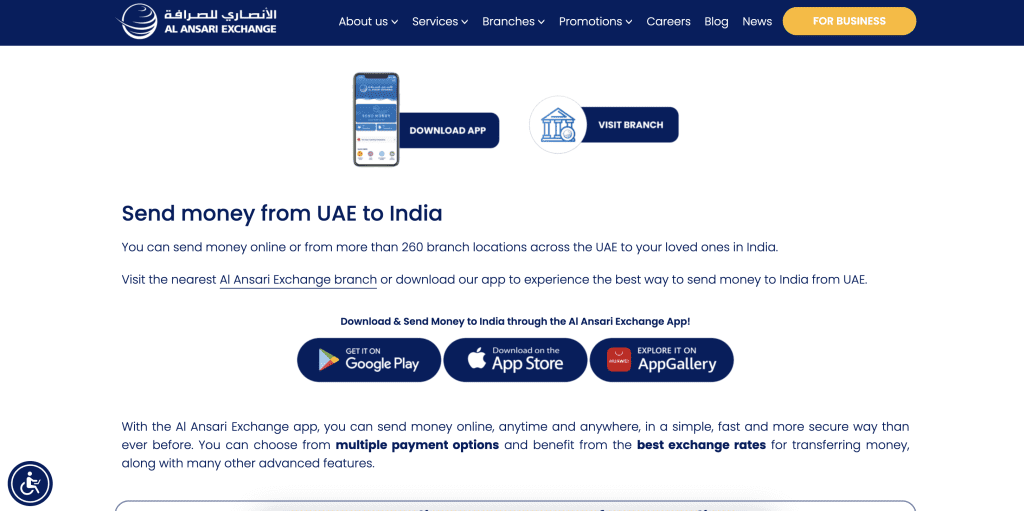
3. Setup heatmaps to find issues & opportunities
Heat mapping tools allow you to see exactly what users are doing when entering your website.
This provides you with exact data on what is causing the issues and where the areas of opportunity are.
Data is collected for the following:
- User click patterns
- Scroll depth
- Mouse movement tracking
- Friction points
- Form interaction points
- Navigation paths
- Drop-off points
- CTA effectiveness
- Device-specific behaviour
- Page load impact on engagement
Find the pages that are underperforming, split A/B test changes and see your conversion rates skyrocket.
Popular tools for heat mapping include Microsoft Clarity, Crazy Egg and Hotjar, to name a few.

4. Leverage internal data for your content strategy
That’s right, the data you’ve already collected can massively assist your SEO campaign.
A great way to build an ROI focused content strategy is to speak to your sales teams and understand the biggest pain points of your customers.
For example, when creating a content strategy for Al Ansari Exchange, we found out that a lot of customers faced issues on other platforms regarding the service fees for money exchange.
This is something their sales reps and customer service teams heard often, and by optimising the brand’s content to appear for said terms – despite being an informational-led topic, it drove a 35% increase in traffic and 22% increase in registrations.
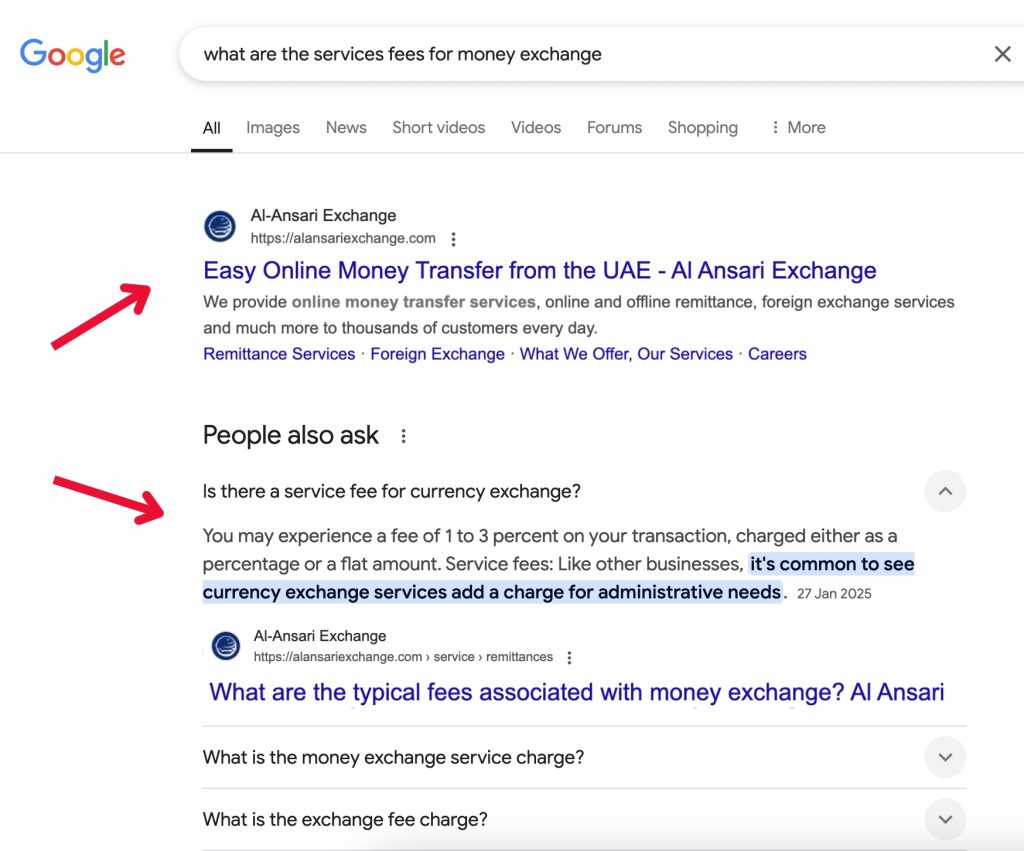
5. Understand organic assisted conversion (GA4 attribution models)
GA4 (Google Analytics 4) has multiple attribution models, meaning different ways to track which channels (such as organic and paid direct) are driving revenue.
The GA4 attribution models can be broadly grouped into the following categories:
#1 Paid and organic channels – This includes ‘Data-driven’ and ‘Paid and organic last click’ attribution models.
#2 Google paid channels – This includes the ‘Google paid channels last click’ attribution model.
By reviewing the attribution paths, you can start to figure out what content plays a role in the conversion journey, even if it’s not being attributed to SEO.
For example, for considered purchases (typically of a higher $ amount), it often takes multiple visits to the website.
They may originally find your brand on organic search, leave the website – and then return via social media retargeting, or via a brand term on Google Ads.
While organic didn’t ‘close’ them, it was the original source of the visit, and as such signifies a crucial step to generate greater ROI.

What you need to do to start actioning this shift immediately
Now, I want to reiterate – that impressions, sessions and keyword rankings are all important metrics to track the success of your SEO campaign.
But that’s where they need to stay – as metrics and KPIs.
The ultimate goal of your SEO campaign should be focused on ROI and revenue, and then you should work back from there in terms of the changes you need to make.
Doing this makes the long list of SEO actions much clearer, and it’s easier to identify the stuff that will make you money vs. the things that become box-ticking exercises.
To get this started:
Shift your KPIs: Start with the conversion metrics and work back from there (leads, purchases, customer lifetime value).
Map your content to the buyer journey: Create content that directly supports concerns, friction points and purchase intent.
Accurately track your data: Implement the right tools to monitor revenue impact.
- Google Analytics 4
- Google search console
- Google Ads
- Heat Mapping software
Review & adjust: Regularly audit your SEO strategy and results, and then build upon what you have learned.
Look, I get it… tracking impressions and keyword rankings feels like progress. But if those numbers aren’t driving actual revenue, what’s the point? Shifting to an ROI-first SEO strategy isn’t as hard as it seems, as hopefully, content has explained.
It’s about doing the right SEO. Consistently.
And trust me, once you start focusing on ROI, everything else falls into place.
A big thank you to Oscar, SEO & Performance Strategist of SEO Sherpa, for sharing his expertise on why businesses should move beyond vanity metrics and focus on ROI-driven SEO strategies. His insights serve as a roadmap for companies looking to maximise their digital marketing efforts and drive real revenue growth. If you’re ready to shift your SEO approach, now’s the time to take action!
Join Us Now!
Want to learn more and take your marketing strategy to the next level? Join us at our upcoming summits, where we bring innovation, networking, and thought leadership to exciting new destinations across the globe in 2025! We look forward to meeting you in person.
➡ Explore the 2025 full calendar here! https://beetc.io/2025-full-event-calendar-beetc/
➡ Interested in becoming a partner? Don’t hesitate to get in touch with us at sponsor@themartechsummit.com.
Stay up to date with our In Person Summit, Session Information, and Agenda Updates by following us on:
See more MarTech Thoughts Content/ Interview pieces here!
Last updated: March 2025



